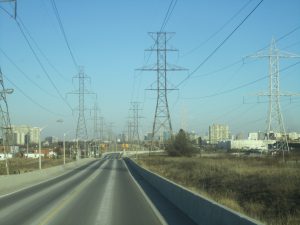By Roger Keil
The publication of the report on working poverty in Toronto last week by John Stapleton, Brian Murphy and Yue Xing for the Metcalf Foundation raises important issues around the continued widening of the socioeconomic gap in this city. The lack of transit connectivity in those inner suburban neighbourhoods where the working poor are most likely to live, is a big piece of the problem. In a chapter for a forthcoming book on Neighbourhood Belonging and Mobilities in the City and the Suburb, edited by Paul Watt and Peer Smets, Douglas Young and Roger Keil take up this central issue. We preview the modified draft conclusion for the chapter here:
We argued elsewhere that a new politics of transit needs to explode hierarchical notions of urban space as well as the more linear models of social inclusion that rest on these notions. Periphery-to-centre links through better supply of hard and soft infrastructures are not enough. The complex networked mobility needs and realities in the ‘cities in waiting’ constitute a challenge to that view. And traditionally marginalized communities are raising their political voice. This recognizes that mobility in and between neighbourhoods is dynamic and reflective of larger societal changes. In this view, Transit City’s light-rail and rapid bus routes were merely minimum requirements of a new politics of infrastructure that must ultimately involve not only a larger systemic view of mobility but also lateral connection with the city’s neighbourhoods as places of work, education, residence and entertainment. The neocolonialist centrist attitude that treats inner suburbs as nondescript hinterlands and exurban communities as helplessly lost to the automobile must be up for change. The inner suburban neighbourhoods from Etobicoke to North York and Scarborough have been beginning to make their political weight felt. The exurban communities are beginning to outshine the gridlocked central cities.
A central contradiction remains at the heart of the new mobility regime in Toronto which we assume to be equally relevant in other jurisdictions. The newly emergent post-suburban spaces of the “city in waiting” require a complex approach to transit and transportation. In order for neighbourhoods to be linked to mobility networks at various scales, the classical hierarchy in transit and transportation provision must be challenged. It can be assumed now that not all logic of connectivity emanates from the centre. There are other logics of connectivity, too, which we are just beginning to understand. At the heart of the spatial reorientation our urban regions go through in this period of urbanization is the recognition that the multitudinous speeds, scales and accessibilities of networked infrastructures in major cities are hard to reconcile with each other. In Toronto, as we have seen, the traditional centre-oriented model had marginalized huge areas of settlement and employment, commercial spaces, educational facilities and other public institutions in the suburbs.
Transit City (as well as its reincarnation in the recent compromise solution initiated by TTC Chair Karen Stintz) and more recent exurban efforts attempted to counteract the lopsidedness of public transit in the metropolitan area. Metrolinx had originally been interested in faster and farther-reaching technologies of rail-based transit yet they worked with the TTC's Transit City, which operated on a smaller scale with a less regional set of technologies (Light Rail Transit). Mayor Rob Ford immediately mothballed Transit City after his election in 2010 and introduced the idea of an underground Eglinton Crosstown rail line, which enraged his critics who charged him with squandering public money on a project he did not understand well. Lastly, in this saga of scalar jumps and institutional reorganization, the new TTC Chair proposed another compromise that would save some of Transit City’s original ideas which is the status quo of transit planning in Toronto at the time of this posting.
Yet, it is now necessary to look beyond this recent compromise. Toronto obviously cannot operate with a transit system that is scaled to fit the needs of the local level alone. It needs to make the fast regional connections also. Transit City was a blueprint for better connectivity among its poorest communities and within them but it had neglected the larger network of regional transit which makes connections region-wide. Only in the dialectic of local and supra-local transportation choices lies the possibility of creating better internal mobility in and better connectivity outside for post-suburbia.


